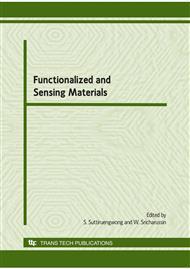p.619
p.623
p.627
p.631
p.635
p.639
p.643
p.647
p.651
The Synthesis of Titanium Dioxide Emulsion as UV Blocking
Abstract:
The solar light consists of ultraviolet, visible and infrared ray. The ultraviolet and infrared rays, unlike visible ray, are not benefit to photosynthesis. Inorganic ultraviolet absorbing materials are mostly in crystallised phase such as TiO2, ZnO and CeO2 which caused lower transmittion in visible range. As known that, the commercial organic UV absorbers can absorb only the appointed UV wavelength. TiO2 emulsion for ultraviolet blocking was synthesized in this project in order to overcome such poor transmittion behavior. The preparative TiO2 emulsion can absorb UV completely without interfering the visible light transmittance. This is because the synthesized TiO2 via emulsion method was mainly an amorphous phase. The obtained composite film containing amorphous phase of TiO2 shows 80-90% transmittance of the visible light, 20-70% absorbance of ultraviolet A and 70-95 % absorbance of ultraviolet B.
Info:
Periodical:
Pages:
635-638
Citation:
Online since:
January 2010
Keywords:
Price:
Сopyright:
© 2010 Trans Tech Publications Ltd. All Rights Reserved
Share:
Citation:


